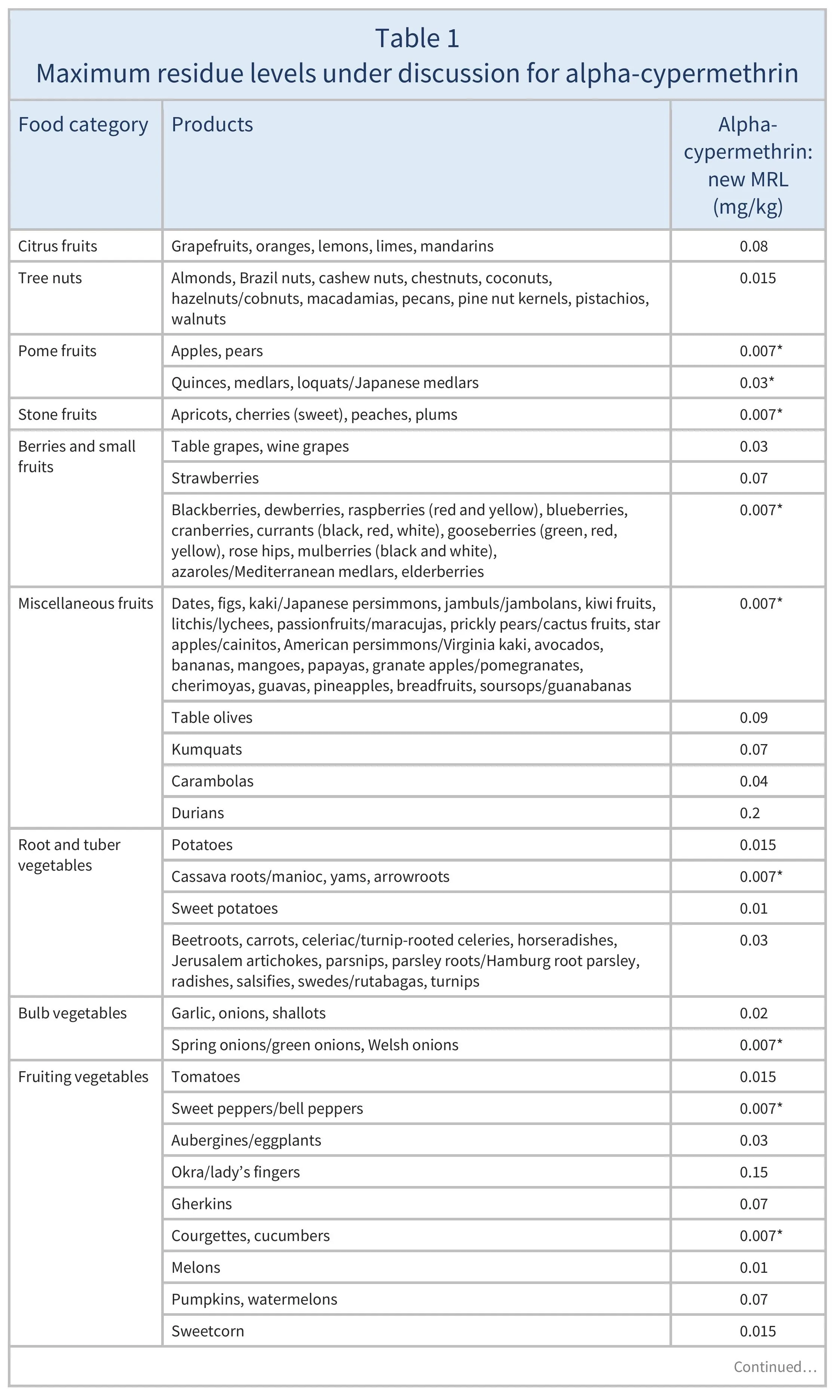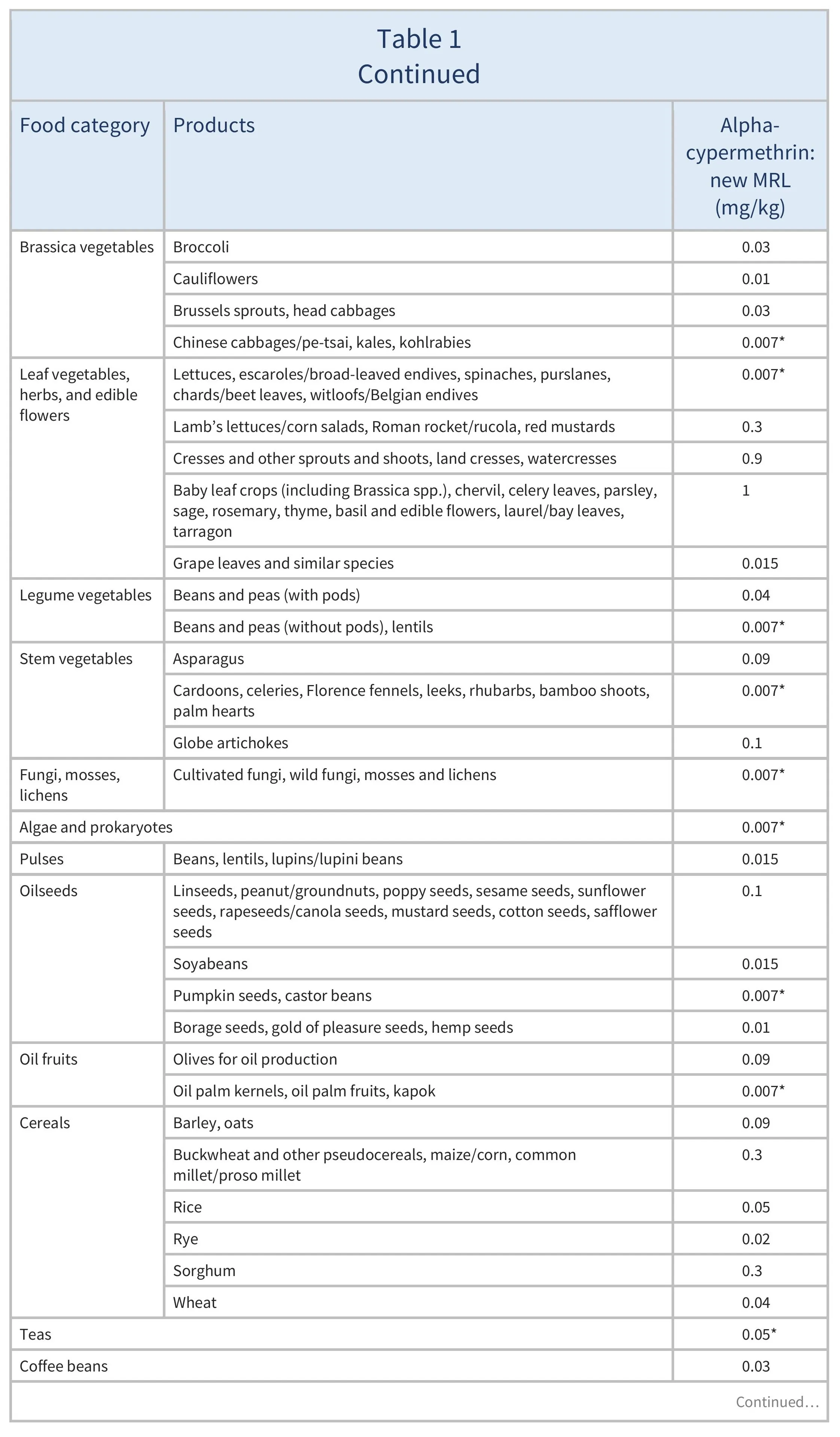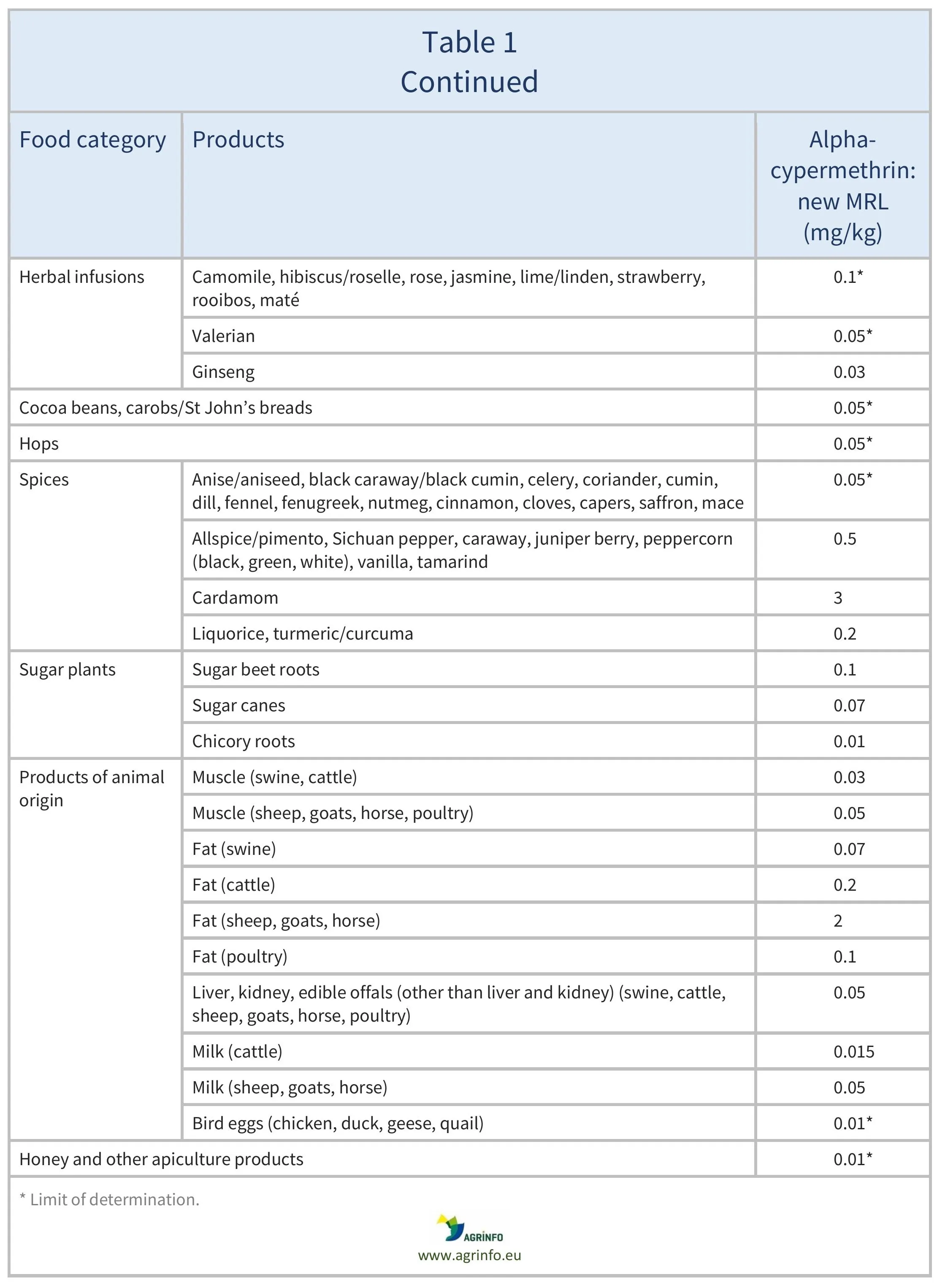Maximum residue levels for alpha-cypermethrin
- Food safety
- Pesticide MRLs
Summary
The current maximum residue levels (MRLs) for cypermethrin cover the group of isomers: cypermethrin, alpha-cypermethrin, beta-cypermethrin, and zeta-cypermethrin. The European Food Safety Authority has identified potential risks related to the current cypermethrin MRLs for certain products, with particular concerns regarding alpha-cypermethrin, which is more toxic. The European Union (EU) is therefore discussing setting specific MRLs for alpha-cypermethrin, in addition to the general MRL covering all forms of cypermethrin. In parallel, the EU is also reviewing the cypermethrin MRLs (see Maximum residue levels for cypermethrins).
EU discusses setting MRLs for for alpha-cypermethrin
Draft Commission Regulation amending Annexes II and III to Regulation (EC) No 396/2005 of the European Parliament and of the Council as regards maximum residue levels for alpha-cypermethrin and cypermethrin in or on certain products [download]
Draft Annex [download]
Update
The current maximum residue levels (MRLs) for cypermethrin cover the group of isomers: cypermethrin, alpha-cypermethrin, beta-cypermethrin, and zeta-cypermethrin. The European Food Safety Authority has identified potential risks related to the current cypermethrin MRLs for certain products, with particular concerns regarding alpha-cypermethrin, which is more toxic. The European Union (EU) is therefore discussing setting specific MRLs for alpha-cypermethrin, in addition to the general MRL covering all forms of cypermethrin. In parallel, the EU is also reviewing the cypermethrin MRLs (see Maximum residue levels for cypermethrins).
Impacted Products
Grapefruits, oranges, lemons, limes, mandarins, almonds, Brazil nuts, cashew nuts, chestnuts, coconuts, hazelnuts, macadamias, pecans, pine nut kernels, pistachios, walnuts, apples, pears, quinces, medlars, loquats/Japanese medlars, apricots, cherries (sweet), peaches, plums, table grapes, wine grapes, strawberries, blackberries, dewberries, raspberries (red and yellow), blueberries, cranberries, currants (black, red, white), gooseberries (green, red, yellow), rose hips, mulberries (black and white), azaroles/Mediterranean medlars, elderberries, dates, figs, kaki/Japanese persimmons, jambolans, kiwi fruits, litchis, passionfruits/maracujas, prickly pears, star apples/cainitos, American persimmons/Virginia kaki, avocados, bananas, mangoes, papayas, granate apples/pomegranates, cherimoyas, guavas, pineapples, breadfruits, soursops, table olives, kumquats, carambolas, durians, potatoes, cassava roots, yams, arrowroots, sweet potatoes, beetroots, carrots, celeriac, horseradishes, Jerusalem artichokes, parsnips, Hamburg root parsley, radishes, salsifies, swedes/rutabagas, turnips, garlic, onions, shallots, spring onions/green onions, Welsh onions, tomatoes, sweet peppers/bell peppers, aubergines/eggplants, okra/lady’s fingers, gherkins, courgettes, cucumbers, melons, pumpkins, watermelons, sweetcorn, broccoli, cauliflowers, Brussels sprouts, head cabbages, Chinese cabbages/pe-tsai, kales, kohlrabies, lettuces, escaroles/broad-leaved endives, spinaches, purslanes, chards/beet leaves, witloofs/Belgian endives, lamb’s lettuces/corn salads, Roman rocket/rucola, red mustards, cresses and other sprouts and shoots, land cresses, watercresses, baby leaf crops (including Brassica species), chervil, celery leaves, parsley, sage, rosemary, thyme, basil and edible flowers, laurel/bay leaves, tarragon, grape leaves, beans and peas (with and without pods), lentils, asparagus, cardoons, celeries, Florence fennels, leeks, rhubarbs, bamboo shoots, palm hearts, globe artichokes, cultivated/wild fungi, mosses and lichens, algae and prokaryotes, beans, lentils, lupini beans, linseeds, peanuts/groundnuts, poppy seeds, sesame seeds, sunflower seeds, rapeseeds/canola seeds, mustard seeds, cotton seeds, safflower seeds, soyabeans, pumpkin seeds, castor beans, borage seeds, gold of pleasure seeds, hemp seeds, olives for oil production, oil palm kernels and fruits, kapok, barley, oat, buckwheat, maize/corn, millet, rice, rye, sorghum, wheat, chamomile, hibiscus, rose, jasmine, lime, strawberry, rooibos, maté, valerian, ginseng, aniseed, black cumin, celery, coriander, cumin, dill, fennel, fenugreek, nutmeg, cinnamon, cloves, capers, saffron, mace, allspice/pimento, Sichuan pepper, caraway, juniper berry, peppercorn (black, green, white), vanilla, tamarind, cardamom, liquorice, turmeric, sugar beet roots, sugar canes, chicory roots, muscle/fat/liver, kidney/edible offals (swine, cattle, sheep, goats, equine, poultry), bird eggs (chicken, duck, geese, quail)
What is changing?
The EU is discussing setting separate MRLs for alpha-cypermethrin, as summarised in Table 1.
Why?
While cypermethrin is a pesticide authorised for use in the EU, alpha-, beta-, and zeta-cypermethrin are not. The MRL for cypermethrin refers to the group of all these isomers.
The European Food Safety Authority has identified potential risks related to the current cypermethrin MRL for certain products (EFSA 2023). As these risks are often associated with the more toxic alpha-cypermethrin, rather than reduce cypermethrin MRLs to the limit of determination (LOD), the European Commission proposes two sets of MRLs, one for cypermethrin (sum of isomers), and a separate one for alpha-cypermethrin. This approach will allow the EU to maintain cypermethrin MRLs for many products identified as a risk, and also maintain alignment with Codex Alimentarius MRLs (CXLs) (European Commission 2024).
EFSA has provided further guidance on setting MRLs for alpha-cypermethrin (EFSA 2025).
Timeline
This Regulation is still under discussion and is expected to be adopted in 2026.
Background
MRLs are set in accordance with the rules set out in Regulation 396/2005. For information on current MRLs for other substances, please consult the EU Pesticide Residues database.
Resources
EFSA (2023) Review of the existing maximum residue levels for cypermethrins according to Article 12 of Regulation (EC) No 396/2005. EFSA Journal, 21(3): 7800.
EFSA (2025) Statement on MRLs for alpha-cypermethrin and screening of the existing EU MRLs for cypermethrin. EFSA Journal, 23: e9386.
European Commission (2024) Standing Committee on Plants, Animals, Food and Feed Section Phytopharmaceuticals – Pesticide Residues 23 - 24 September 2024
Sources
Draft Commission Regulation as regards maximum residue levels for alpha-cypermethrin and cypermethrin in or on certain products [download]
Draft Annex [download]
Tables & Figures
Disclaimer: Under no circumstances shall COLEAD be liable for any loss, damage, liability or expense incurred or suffered that is claimed to have resulted from the use of information available on this website or any link to external sites. The use of the website is at the user’s sole risk and responsibility. This information platform was created and maintained with the financial support of the European Union. Its contents do not, however, reflect the views of the European Union.
EU discusses setting MRLs for for alpha-cypermethrin
Draft Commission Regulation as regards maximum residue levels for alpha-cypermethrin and cypermethrin in or on certain products [download]
Draft Annex [download]
What is changing and why?
The current maximum residue levels (MRLs) for cypermethrin cover the group of isomers: cypermethrin, alpha-cypermethrin, beta-cypermethrin, and zeta-cypermethrin. The European Food Safety Authority has identified potential risks related to the current cypermethrin MRLs for certain products, with particular concerns regarding alpha-cypermethrin, which is more toxic. The European Union (EU) is therefore discussing setting specific alpha-cypermethrin MRLs (see Table 1) in addition to the general MRL covering all forms of cypermethrin. In parallel, the EU is also reviewing the cypermethrin MRLs (see Maximum residue levels for cypermethrins).
Timeline
This Regulation is still under discussion and is expected to be adopted in 2026.
Tables & Figures
Disclaimer: Under no circumstances shall COLEAD be liable for any loss, damage, liability or expense incurred or suffered that is claimed to have resulted from the use of information available on this website or any link to external sites. The use of the website is at the user’s sole risk and responsibility. This information platform was created and maintained with the financial support of the European Union. Its contents do not, however, reflect the views of the European Union.



